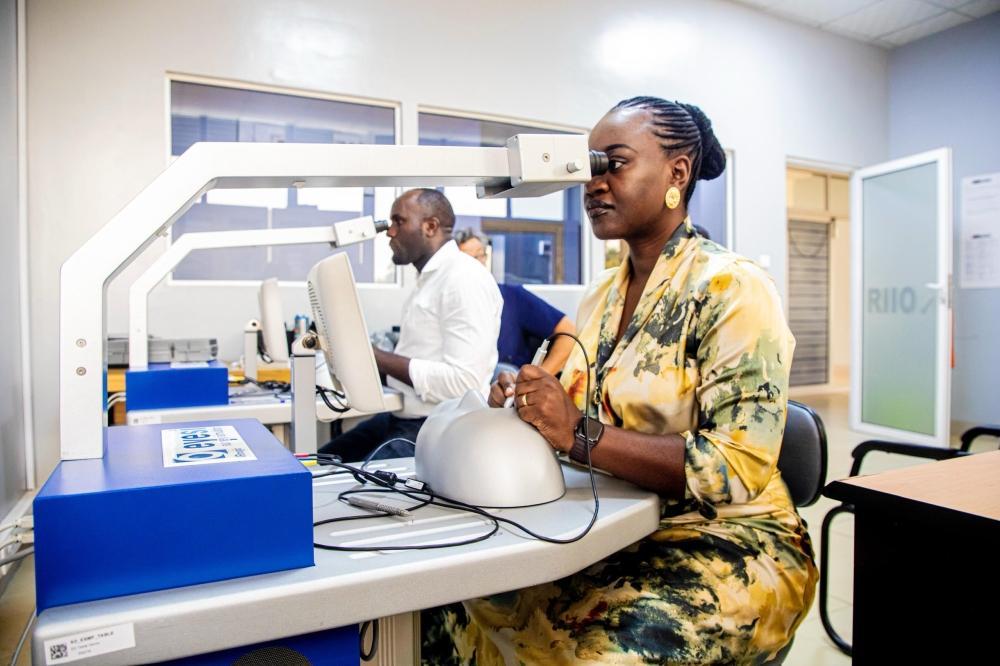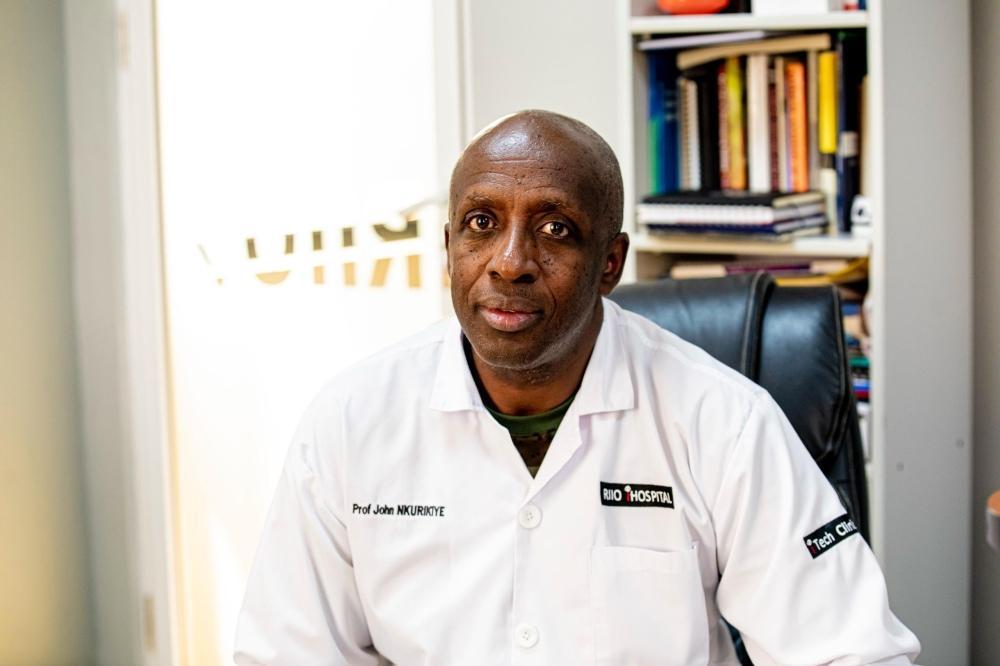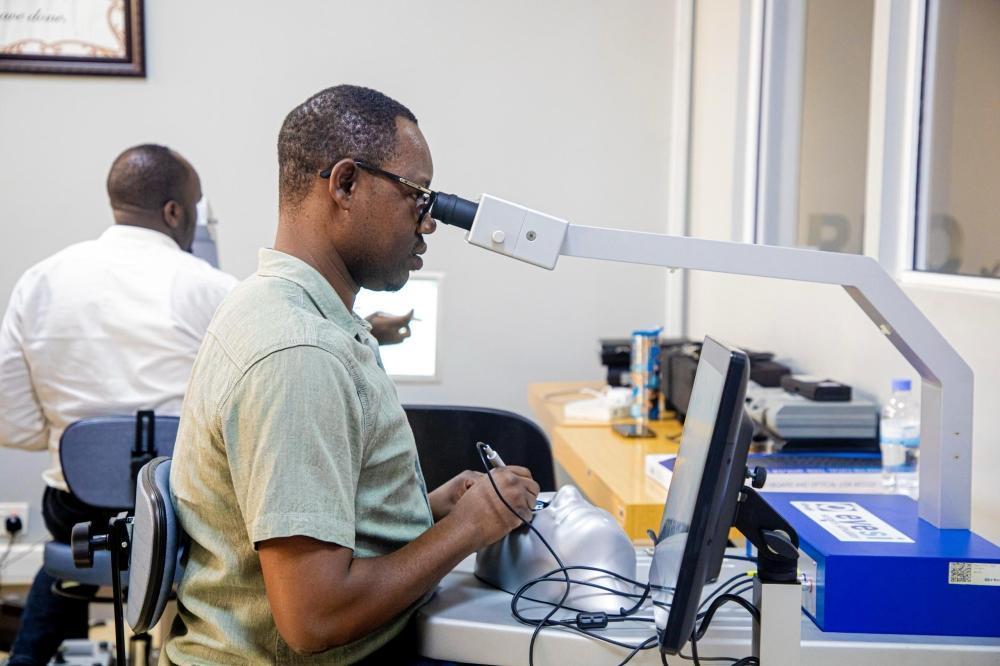Africa-Press – Rwanda. For the first time, Rwanda is hosting the Flying Eye Hospital, a high-tech airborne teaching facility run by Orbis International, which officially launched its two-week mission on July 21 at Kigali International Airport.
Led by Orbis International in partnership with the Ministry of Health and the Rwanda International Institute of Ophthalmology (RIIO), this initiative focuses on training specialists and providing advanced surgeries to reduce the need for patients to seek treatment abroad.
In an interview with The New Times, Dr. John Nkurikiye, the Chief Ophthalmologist at RIIO, explained the impact of the Flying Eye Hospital’s visit, the cutting-edge technology in use, and how the programme fits into Rwanda’s broader plan to strengthen eye care services nationwide.
Dr. John Nkurikiye, Chief Ophthalmologist at the Rwanda International Institute of Ophthalmology, during the interview at his office in Nyarutarama. Photo: Keza Kellya.
The excerpts;
The Flying Eye Hospital is in Rwanda for the first time. What does its presence here really mean for the country’s eye care system?
The Flying Eye Hospital is first and foremost a teaching hospital. It’s not designed to make an immediate impact during its two-week visit here, but its value lies in training and skill development. The plan began when the team landed on Friday, July 18.
By Saturday, they were setting up advanced equipment, like the surgical simulators you saw, so that by Monday, training could start. This first week focuses mainly on training young ophthalmologists, residents who are in the process of becoming specialists using state-of-the-art virtual reality simulators.
These simulators allow trainees to perform surgeries on a three-dimensional computer-based platform that replicates a patient’s eye in detail.
This virtual reality training is high-realistic, meaning it closely mimics real surgery. This is an advancement from previous methods where we used animal eyes for practice.
Can you explain how the training is being rolled out, like where it’s happening, who is involved, and what makes this approach different from what we have had before?
The training takes place in three locations simultaneously, at RIIO, Kibagabaga Hospital, in the plane itself at the Kigali International Airport, which has been outfitted as a classroom and lab, and other hospital spaces. We have 16 residents currently on the plane, along with four trainees from the University of Rwanda.
Six young ophthalmologists are also receiving training. We are training nurses on operating theatre techniques, how to handle and sterilize advanced equipment, anesthesiologists on safe anesthesia procedures for children, and biomedical engineers on maintaining these instruments.
It’s a comprehensive programme for the first week. The second week transitions into performing surgeries, both on the plane and at Kibagabaga Hospital. The volunteer surgical team includes about 12 top surgeons from around the world, the UK, the US, Japan, and Africa, supported by anesthesiologists and other staff.
The entire Orbis team numbers around 50 people, including technicians and logistical staff. The scale of this operation is why the preparation took years and why the visit is so important.
You mentioned that planning to have this hospital in Rwanda took four years. Can you walk us through what that involved?
The process started with showcasing Rwanda as a suitable host country for Orbis. We had to demonstrate that we have the infrastructure, professionalism, and commitment to support this complex project.
Once we reached an agreement, we signed a Memorandum of Understanding (MOU) outlining the year and month the Flying Eye Hospital would come.
That’s when we engaged the Ministry of Health and other key partners such as the Civil Aviation Authority, Rwanda Airport Company, and RwandAir because airport logistics are particularly challenging.
We had to identify the exact site where the plane would park, arrange water supply, manage food logistics for the team onboard, and ensure patient access. These agencies worked very professionally and collaboratively to facilitate everything.
The Ministry of Health was also involved in customs clearance to make sure equipment could come in duty-free. RIIO was responsible for identifying the trainees and patients, as well as coordinating local logistics.
How do you determine which patients are selected for surgery during this programme, and what kinds of cases are prioritized?
Patient selection is very deliberate. We first agree with Orbis on the types of specialists they will bring. This year, for example, they brought experts in pediatric ophthalmology, strabismus (commonly called squint), and oculoplastic surgery.
Oculoplastic surgery is like plastic surgery but focuses on the tissues around and behind the eye. It’s reconstructive, not cosmetic, addressing trauma, tumors, or tissue damage that could affect eye function. Strabismus cases can be straightforward, but some are difficult due to nerve paralysis or oblique muscle issues.
Those require expert intervention. These are the cases we prioritize for the Flying Eye Hospital. We do not conduct on-the-spot screening; rather, we have pre-screened and listed patients in advance. Their histories and imaging results are uploaded to a shared platform so that visiting surgeons can review them ahead of time. This also guides what specialized equipment needs to come with the team.
How is Rwanda building its own capacity to train and retain ophthalmologists, and what’s the long-term vision for eye care services across the country?
We started training ophthalmologists locally in 2018, and our first graduates came in 2022. The training continues, with about 16 currently enrolled. We want to replicate the success we have had at Kibagabaga Hospital in other regions like Ruhengeri, Rwamagana, and Kibuye.
The goal is to equip these sites with better infrastructure and equipment, so they can also become training centers. With partners like the Fred Hollows Foundation (an international nonprofit organization focused on preventing and treating preventable blindness), we are working toward expanding training capacity across the country.
The aim is to produce ophthalmologists who can sub-specialize in areas such as pediatric ophthalmology, glaucoma, cornea, and retina, covering the full spectrum of eye diseases locally. At that point, the need for visiting experts will decrease, visits will be for collaboration or research, not necessity.
How has technology, especially the use of AI and simulators, improved eye care training?
Before, we practiced on animal eyes got from slaughterhouses, which had to be discarded after use and required constant resupply. Now, virtual reality simulators provide a realistic surgical experience without needing animal tissue.
One simulator will stay in Rwanda after the programme, based at Kibagabaga Hospital. Costing between $150,000 and $200,000, it speeds up training, procedures that once took six months to master can now be learned in four weeks, improving skills and confidence.
What specific skills does the training programme focus on, and how does it help ophthalmologists manage various eye conditions?
The programme focuses on skills development, ophthalmologists master these surgical skills, they can address a wide range of eye conditions effectively.
Currently, trainees practice surgeries for glaucoma, cataracts, strabismus, and laser treatments. Comprehensive training equips doctors to tackle diverse eye problems and later specialize in specific areas.
Rwanda is the 84th country to host the Flying Eye Hospital, which started in 1982. Do you see this as a one-time event or the beginning of ongoing collaborations?
We will remain connected with Orbis. Dr. Ciku Mathenge, the co-founder of RIIO, is Orbis’ medical advisor for Africa, which strengthens our relationship. In future meetings, we identify needs and decide when Rwanda might be ready to host again.
Now that Rwanda has hosted, and with strong support from the Ministry of Health and professional airport authorities, it will be easier to welcome them again. Orbis and Rwanda have built a partnership that adds value for both sides.
Can you describe how the Flying Eye Hospital is arranged inside the plane?
The plane’s front section is a classroom with seats and audiovisual equipment for lectures and demonstrations. Behind that, the cargo area is partitioned into a modular system housing a simulation center, operating room, sterilization room, and recovery room. The space is very functional despite being compact. There is a corridor with viewing windows allowing observers to watch surgeries live, which are projected onto screens for all students to follow.
As someone who has witnessed Rwanda’s eye care evolution, what does this moment represent?
When I started practicing ophthalmology in Rwanda in 2001, there were only three ophthalmologists, including myself, and not all were surgeons. Now, 25 years later, we have 32 practicing ophthalmologists. Previously, most young ophthalmologists were trained abroad and not allowed to perform surgery.
We had to train them here to become surgeons, which led us to start our local training programme at RIIO in 2018.Our first graduates have been immediately employed without needing further training, which shows the quality of our programme. The next phase is to develop trainers who can absorb more advanced knowledge and train others, expanding our capacity sustainably.
Could you describe your vision for scaling up ophthalmology training in Rwanda and how this will improve access to quality eye care nationwide?
We plan to replicate what we have done at Kibagabaga Hospital in Ruhengeri, Rwamagana, and Kibuye. These are places where our first graduates are based. With adequate equipment, infrastructure, and ongoing skill development, these sites will become new training centers. Our partnership with Fred Hollows Foundation supports expanding these regional hubs. Our vision focuses on training both the numbers and the skills.
We want to train locally and train well. We earned international accreditation for our advanced training programme, the first in Africa, which reflects our commitment to quality. Our work includes treatment, training, and community outreach. The Flying Eye Hospital is part of this range, providing world-class training and improving care. People no longer need to travel abroad for eye care.
We have the equipment, expertise, and ongoing training to treat most eye conditions here.This is progress from when patients had to travel and spend substantial funds for treatment. We are not yet at full capacity, but the foundation is strong, and the trajectory is promising.
For More News And Analysis About Rwanda Follow Africa-Press








